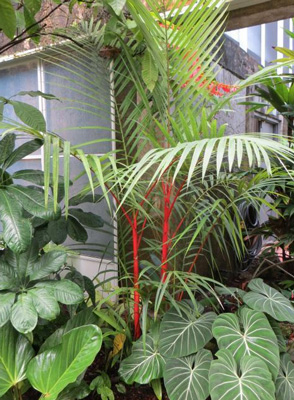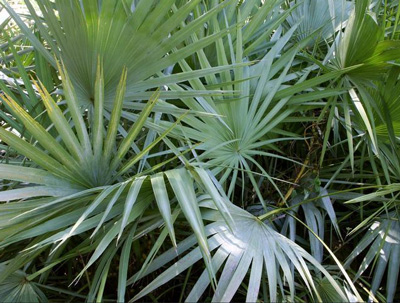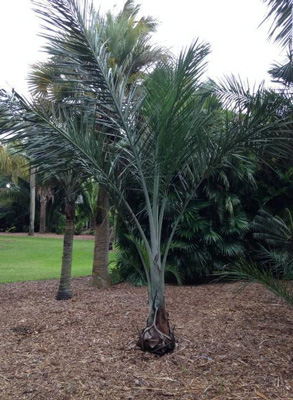Palm enthusiasts and collectors choose their favorite palm with an array of criteria. Some pick it based on looks alone; the red lipstick palm (Cyrtostachys renda) is coveted because of its stately red trunk.

The red lipstick palm (Cyrtostachys renda) is popular because of its flashy trunk. They are extremely cold sensitive and generally don't like our southern Florida soils, but can be cultivated with careful maintenance. Sara Edelman/FTBG.
Some select based on uniqueness: the gingerbread palm (Hyphaene thebaica) has dichotomous branching found only in a handful of palms.
And others determine their No. 1 palm based on rarity: Corypha taliera was cut down to extinction because its strange flowering induced folklore that frightened villagers.
Sadly, a large group of great palms is habitually overlooked by enthusiasts because they aren’t striking, unique or rare. These palms are like the “nice guys” — often overlooked, repeatedly dateless but completely deserving of more attention.
Saw palmetto (Serenoa repens) is perhaps the best example of these forgotten palms. There are so many reasons for this palm to be cherished, but it’s constantly overlooked because of its homely growth habit. The flowers are a great nectar source for bees. In fact, the honey is coveted by beekeepers and honey growers as the best and most delicious. You can even find honey from saw palmetto at some local farmers’ markets.
Florida black bears use the saw palmetto to find food. They injure the trunk of this clumping palm, after which palm weevils invade the trunk. The black bear returns and feasts on the weevils. If this does not work, the bears will settle for the fruit.
Saw palmetto is a great landscape ornamental since it is low maintenance and does well in dry, sunny and cold conditions — unlike most palms.

Saw Palmetto (Serenoa repens). Sara Edelman/FTBG.
Pseudophoenix lediniana is like the shy sister — it can be forgotten about since its congeners are more eye-catching. Pseudophoenix sargentii is a Florida native currently threatened by habitat loss, P. ekmanii has a unique swollen belly, and P. vinifera is used for wine. P. lediniana is the best grower and does well in all conditions.

Pseudophoenix lediniana is habitually overlooked because its congeners are more attention-grabbing, a textbook example of the “shy sister.” Sara Edelman/FTBG.
While most palms can’t tolerate our soils, this palm loves our limestone earth. If your property is like most in Miami, it has a thin layer of topsoil over limestone rock. Roots of this palm will break up the stone and soon you will be able to plant other plants in your yard. Not only is it a great grower, it is an even better facilitator.
Acoelorrhaphe wrightii, the Paurotis palm, used to be very popular as a landscape ornamental but lost favor after inappropriate planting left many individuals with severe frizzle top. Although not as popular in the horticulture trade, this palm is very important in the wild. It grows in seasonally flooded parts of the Everglades. By branching at the base, the Paurotis palm forms clumps. During periods of heavy flooding, these clumps are a place of refuge for Everglades critters. With huge ecological importance, it is quite surprising that relatively little is known about this palm, making it a forgotten palm indeed.

The Paurotis palm (Acoelorrhaphe wrightii) is important ecologically because it creates refuge for animals during floods but is often overlooked because it is not extremely striking, rare or unique. Sara Edelman/FTBG.
This palm would be great along your canal or pond. It can handle sun or shade as long as its feet are wet, at least seasonally.
These palms are treated as runts of the litter but they deserve more attention than they receive. Each of these palms would make an excellent addition to your palm collection. While not the homecoming kings of the palm world, they’d still make an excellent date to the dance.
Sara Edelman is the palm and cycad manager at Fairchild Tropical Botanic Garden.
